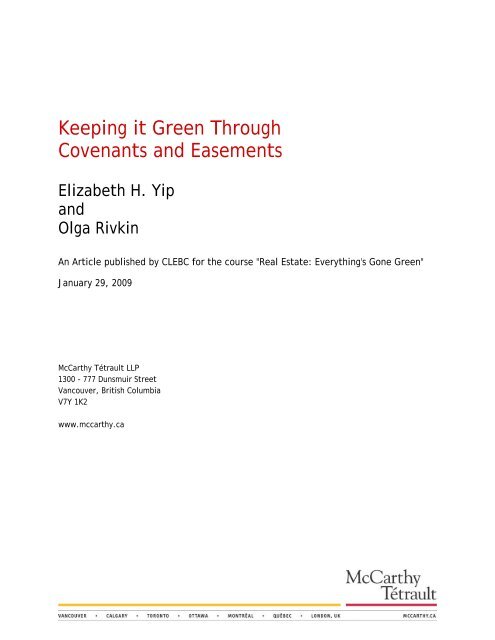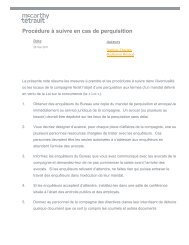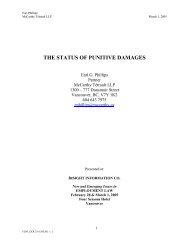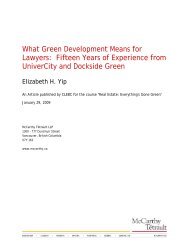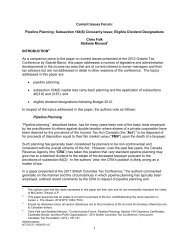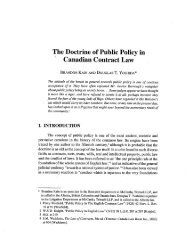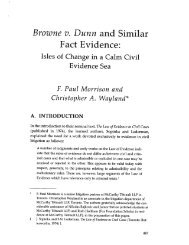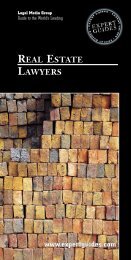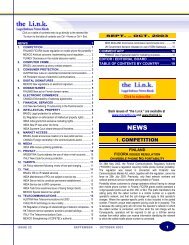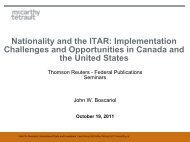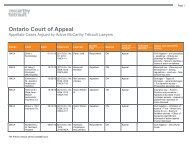Keeping it Green Through Covenants and ... - McCarthy Tétrault
Keeping it Green Through Covenants and ... - McCarthy Tétrault
Keeping it Green Through Covenants and ... - McCarthy Tétrault
You also want an ePaper? Increase the reach of your titles
YUMPU automatically turns print PDFs into web optimized ePapers that Google loves.
<strong>Keeping</strong> <strong>it</strong> <strong>Green</strong> <strong>Through</strong><br />
<strong>Covenants</strong> <strong>and</strong> Easements<br />
Elizabeth H. Yip<br />
<strong>and</strong><br />
Olga Rivkin<br />
An Article published by CLEBC for the course "Real Estate: Everything's Gone <strong>Green</strong>"<br />
January 29, 2009<br />
<strong>McCarthy</strong> Tétrault LLP<br />
1300 - 777 Dunsmuir Street<br />
Vancouver, Br<strong>it</strong>ish Columbia<br />
V7Y 1K2<br />
www.mccarthy.ca
<strong>Keeping</strong> <strong>it</strong> <strong>Green</strong> <strong>Through</strong> <strong>Covenants</strong> <strong>and</strong> Easements<br />
I. INTRODUCTION<br />
In this paper, we will explore the tools available to the developer in creating <strong>and</strong> maintaining a<br />
sustainable development. L<strong>and</strong> t<strong>it</strong>le instruments such as covenants, statutory rights of way <strong>and</strong><br />
easements are obviously useful. Commun<strong>it</strong>y organizations <strong>and</strong> other ent<strong>it</strong>ies established by the<br />
developer also have a role to play. We will refer to the example of two large scale master planned<br />
commun<strong>it</strong>ies – Dockside <strong>Green</strong> in Victoria <strong>and</strong> UniverC<strong>it</strong>y in Burnaby.<br />
II.<br />
TYPES OF LAND TITLE INSTRUMENTS<br />
A. Section 219 <strong>Covenants</strong><br />
Restrictive covenants registered under section 219 of the L<strong>and</strong> T<strong>it</strong>le Act are used to impose obligations<br />
or restrictions w<strong>it</strong>h respect to the use of l<strong>and</strong> or the buildings erected on the l<strong>and</strong>. Section 219 of the<br />
L<strong>and</strong> T<strong>it</strong>le Act is reproduced in Schedule A hereto.<br />
1. Purpose<br />
Since a section 219 covenant can be pos<strong>it</strong>ive or negative in nature, <strong>it</strong> is extremely flexible <strong>and</strong> can be<br />
used for many different purposes. The covenant can be comprehensive; for example, in Victoria, the<br />
master development agreement in favour of the C<strong>it</strong>y of Victoria (“MDA”) was attached to a section 219<br />
covenant. The covenant can also be specific; for example, at UniverC<strong>it</strong>y, many different, specific<br />
covenants were used.<br />
2. Grantee<br />
The section 219 covenant is usually granted as cond<strong>it</strong>ions of subdivision, rezoning or development<br />
approval in favour of the local government where the development is s<strong>it</strong>uated, as well as other<br />
government agencies described in section 219(1) of the L<strong>and</strong> T<strong>it</strong>le Act. In a master planned<br />
development w<strong>it</strong>h certain facil<strong>it</strong>ies <strong>and</strong> programs that the developer wants to maintain after the in<strong>it</strong>ial<br />
construction, the master developer may want a permanent covenant registered on t<strong>it</strong>le independent of<br />
any requirement of the local government.<br />
A restrictive covenant is not registrable under section 221 of the L<strong>and</strong> T<strong>it</strong>le Act unless:<br />
(1) the obligation that the covenant purports to create is, in the registrar’s opinion,<br />
negative or restrictive; <strong>and</strong><br />
(2) a dominant tenement will benef<strong>it</strong> from the covenant.<br />
Since the obligation in the restrictive covenant must be framed negatively, a restrictive covenant is<br />
more difficult to draft <strong>and</strong> register than a section 219 covenant. Further, the master developer may<br />
not own any property which may be a su<strong>it</strong>able dominant tenement after the project is built out <strong>and</strong><br />
Page 1<br />
<strong>Keeping</strong> <strong>it</strong> <strong>Green</strong> through <strong>Covenants</strong> <strong>and</strong> Easements
sold. In this s<strong>it</strong>uation, designating an author<strong>it</strong>y to be the grantee under a section 219 covenant, as<br />
perm<strong>it</strong>ted under section 219(3)(c), is an option available to the developer. The master developer<br />
makes an application to the Surveyor General, who will grant the designation on terms <strong>and</strong> cond<strong>it</strong>ions<br />
he or she thinks proper. If the application is granted, the master developer can use section 219<br />
covenants as a device to maintain control over any aspect of the development over the long term.<br />
3. Run w<strong>it</strong>h the L<strong>and</strong>s<br />
A section 219 covenant is binding on the covenator <strong>and</strong> the covenantor’s successors on t<strong>it</strong>le.<br />
Therefore, <strong>it</strong> can be enforceable against successive owners, including persons w<strong>it</strong>h whom <strong>it</strong> has no<br />
priv<strong>it</strong>y of contract, over the life of the commun<strong>it</strong>y.<br />
B. Statutory Rights of Way/Easements<br />
Section 218 of the L<strong>and</strong> T<strong>it</strong>le Act, which is the legislative author<strong>it</strong>y for statutory rights of way, is<br />
reproduced in Schedule B hereto. Statutory rights of way perm<strong>it</strong> the grantee of the right of way to<br />
access the grantor’s property for the operation or maintenance of the grantee’s undertaking.<br />
In the case of an easement, a dominant tenement, the property which has the benef<strong>it</strong> of the<br />
easement, is required. Section 218 of the L<strong>and</strong> T<strong>it</strong>le Act also perm<strong>it</strong>s the registration of statutory<br />
rights of way in favour of municipal<strong>it</strong>ies <strong>and</strong> other governmental bodies named in section 218(1)<br />
w<strong>it</strong>hout the necess<strong>it</strong>y of having a dominant tenement.<br />
Under section 218(1)(d), any person designated by the Surveyor General may also be a grantee of a<br />
statutory right of way. As in section 219 covenants, master developers of commun<strong>it</strong>ies may take<br />
advantage of this provision to have a specific ent<strong>it</strong>y designated to be the grantee under statutory rights<br />
of way.<br />
A master planned commun<strong>it</strong>y typically consists of many subdivided lots relying on common amen<strong>it</strong>ies,<br />
util<strong>it</strong>ies <strong>and</strong> facil<strong>it</strong>ies. A reciprocal easement benef<strong>it</strong>ing <strong>and</strong> burdening all the subdivided lots gives<br />
each owner the right to access <strong>and</strong> use common facil<strong>it</strong>ies, roads, paths <strong>and</strong> util<strong>it</strong>ies, as well as allowing<br />
for the maintenance of such amen<strong>it</strong>ies. Such an easement typically contains a formula for calculating<br />
the proportionate share of each owner in contributing to the costs in operating <strong>and</strong> maintaining the<br />
common facil<strong>it</strong>ies.<br />
III.<br />
DOCKSIDE GREEN<br />
Dockside <strong>Green</strong> has been described in the media as the “c<strong>it</strong>y of tomorrow”:<br />
Located on a brownfield s<strong>it</strong>e, Dockside <strong>Green</strong> will encompass more<br />
than 20 buildings over 15 acres <strong>and</strong> three neighbourhoods when<br />
completed. …[T]he commun<strong>it</strong>y will be a model of sustainabil<strong>it</strong>y <strong>and</strong><br />
aimed for the highest LEED score of any development to date. 1<br />
1 Chris Peterson, Today Construction, “Windmill West: Dockside <strong>Green</strong>”, January 5, 2009.<br />
Page 2<br />
<strong>Keeping</strong> <strong>it</strong> <strong>Green</strong> through <strong>Covenants</strong> <strong>and</strong> Easements
Dockside <strong>Green</strong>, once completed, will include an on-s<strong>it</strong>e waste water treatment plant (the “Sewage<br />
Plant”), a bio-mass plant for heating (the “District Energy System”), a car cooperative, green roofs,<br />
technology enabling <strong>it</strong>s owners <strong>and</strong> residents to control the level of heat in the su<strong>it</strong>e via Internet, <strong>and</strong><br />
other innovative technologies.<br />
A number of “green” measures, such as dedication of trails <strong>and</strong> conservation of trees, are not unusual<br />
<strong>and</strong> are often required by local governments in large scale developments. Others are purely<br />
technological, such as the abil<strong>it</strong>y to mon<strong>it</strong>or the level of heat in any particular su<strong>it</strong>e via Internet. Some<br />
measures, such as the car cooperative, Sewage Plant <strong>and</strong> District Energy System, require ongoing<br />
mon<strong>it</strong>oring <strong>and</strong> operation.<br />
A. The Developer <strong>and</strong> the Society<br />
Dockside <strong>Green</strong> is developed by Dockside <strong>Green</strong> Lim<strong>it</strong>ed Partnership (“DGLP”). DGLP subdivided the<br />
original l<strong>and</strong>s into a number of different lots. The lots to be used for multi-family residential purpose<br />
will be further stratified. Dockside <strong>Green</strong> (Victoria) Society (the “Society”) was formed w<strong>it</strong>h the<br />
m<strong>and</strong>ate to, inter alia, maintain <strong>and</strong> operate various common amen<strong>it</strong>ies <strong>and</strong> facil<strong>it</strong>ies.<br />
B. The Master Development Agreement<br />
DGLP entered into the MDA w<strong>it</strong>h the C<strong>it</strong>y of Victoria. The MDA set out the parties’ agreement as to the<br />
manner in which Dockside <strong>Green</strong> would be developed. Under the MDA, DGLP was obliged to, inter alia:<br />
• comply w<strong>it</strong>h design guidelines;<br />
• building to certain LEED st<strong>and</strong>ards; <strong>and</strong><br />
• construct <strong>and</strong> provide the Sewage Plant <strong>and</strong> the District Energy System.<br />
The MDA was registered as a section 219 covenant on t<strong>it</strong>le to all of the l<strong>and</strong>s.<br />
C. S<strong>it</strong>e-Wide Instruments<br />
Two s<strong>it</strong>e-wide instruments, a reciprocal easement <strong>and</strong> a statutory right of way in favour of the Society,<br />
were registered on t<strong>it</strong>le to establish a regime for the access to <strong>and</strong> use of common roadways, util<strong>it</strong>ies,<br />
amen<strong>it</strong>ies <strong>and</strong> facil<strong>it</strong>ies including the Sewage Plant (collectively, the “DG Common Facil<strong>it</strong>ies”) by all<br />
Dockside <strong>Green</strong> occupants. The Society has the m<strong>and</strong>ate to operate <strong>and</strong> maintain the DG Common<br />
Facil<strong>it</strong>ies as set out in <strong>it</strong>s bylaws. The statutory right of way grants the Society the legal right to access<br />
the l<strong>and</strong>s for such purpose. The easement grants the owners rights to access other owners’ l<strong>and</strong>s to<br />
carry out maintenance in case the Society fails to do so.<br />
A reciprocal easement binding <strong>and</strong> benef<strong>it</strong>ing all the subdivided lots in Dockside <strong>Green</strong> was registered<br />
to enable access, use <strong>and</strong> maintenance of the DG Common Facil<strong>it</strong>ies. The intent is that the Society will<br />
maintain <strong>and</strong> repair the DG Common Facil<strong>it</strong>ies, so that the owner of a dominant tenement may not<br />
exercise <strong>it</strong>s rights unless the Society ceases to carry out <strong>it</strong>s responsibil<strong>it</strong>ies, <strong>and</strong> even then, such owner<br />
may not exercise <strong>it</strong>s rights except in respect of works that benef<strong>it</strong> <strong>it</strong>s l<strong>and</strong>s exclusively.<br />
Page 3<br />
<strong>Keeping</strong> <strong>it</strong> <strong>Green</strong> through <strong>Covenants</strong> <strong>and</strong> Easements
A statutory right of way, section 219 covenant <strong>and</strong> rent charge have been granted in favour of the<br />
Society to operate <strong>and</strong> maintain the DG Common Facil<strong>it</strong>ies. The agreement contains covenants by the<br />
Society to authorize the mini-trans<strong>it</strong> service <strong>and</strong> car share program <strong>and</strong> to engage in practices<br />
necessary to support the applicable LEED certification levels in maintaining the DG Common Facil<strong>it</strong>ies.<br />
The Society also covenants to prepare an annual budget of the maintenance costs for the DG Common<br />
Facil<strong>it</strong>ies <strong>and</strong> to apportion to each owner <strong>it</strong>s applicable share.<br />
D. Waste Water Treatment Plant<br />
Although responsible for maintaining the Sewage Plant, the Society has contracted w<strong>it</strong>h an operator<br />
experienced in designing, building <strong>and</strong> operating wastewater collection <strong>and</strong> treatment infrastructure to<br />
carry out this function. Accordingly, the Society entered into an Operation <strong>and</strong> Maintenance<br />
Agreement (the “O&M Agreement”) w<strong>it</strong>h DGLP <strong>and</strong> Corix Util<strong>it</strong>ies Inc.<br />
Under the O&M Agreement, Corix is responsible for the operation <strong>and</strong> maintenance of the Sewage<br />
Plant. In the event of an emergency, if <strong>it</strong> is necessary to use the C<strong>it</strong>y of Victoria’s san<strong>it</strong>ary sewer<br />
system to dispose of sewage <strong>and</strong> waste water, the Society would be responsible for paying to the C<strong>it</strong>y<br />
<strong>it</strong>s disposal rates for such use, unless the emergency is due to negligence by Corix.<br />
E. Bio-Mass Plant<br />
The development includes the District Energy System which provides hot water <strong>and</strong> heat for residents.<br />
The premise is that rather than burning wood waste, a thermochemical gasification process can be<br />
used to create a synthetic gas that will be burned to produce heat. The resulting products are then<br />
scrubbed, cleaned <strong>and</strong> burned to produce heat for a heating water boiler, which will supply heat to the<br />
development.<br />
Dockside <strong>Green</strong> Energy LLP (the “Util<strong>it</strong>y”) was established to design, install, own <strong>and</strong> operate the<br />
District Energy System. The Util<strong>it</strong>y is regulated under the Util<strong>it</strong>ies Commission Act.<br />
A statutory right of way, section 219 covenant <strong>and</strong> rent charge will be registered over each subdivision<br />
lot prior to filing of the strata plan. These instruments will be in favour of Dockside <strong>Green</strong> Power Ltd.<br />
(“DG Power”) to enable DG Power to operate <strong>and</strong> maintain the District Energy System. Since the<br />
Util<strong>it</strong>y cannot be a grantee because <strong>it</strong> is a partnership, DG Power shows on the charge as the grantee<br />
instead. The section 219 covenant provides that the owner of the subdivision lot will not do anything<br />
on <strong>it</strong>s l<strong>and</strong>s or buildings which will interfere w<strong>it</strong>h or damage the District Energy System. The rent<br />
charge secures the fees <strong>and</strong> charges payable by the residents which are established by DG Power from<br />
time to time.<br />
F. Car Share Program Agreement<br />
DGLP entered into an agreement w<strong>it</strong>h the Society <strong>and</strong> Victoria Car Share Cooperative (the<br />
“Cooperative”) to create an opportun<strong>it</strong>y for residential <strong>and</strong> commercial owners to participate in a car<br />
sharing program. The in<strong>it</strong>ial ten cars for the program are to be subsidised by DGLP, <strong>and</strong> if further cars<br />
are required, the Cooperative will be responsible for purchasing them.<br />
Page 4<br />
<strong>Keeping</strong> <strong>it</strong> <strong>Green</strong> through <strong>Covenants</strong> <strong>and</strong> Easements
DGLP’s obligations under the agreement terminate on the earlier of the date when all funds required<br />
by DGLP to be paid under the Agreement have been paid, the completion of the construction of<br />
Dockside <strong>Green</strong>, or 2015.<br />
Following termination of DGLP’s obligations, the Cooperative will conduct <strong>it</strong>s business under common<br />
supervision from the Society, which supervision includes designating parking spots necessary for the<br />
operation of the program, negotiating logos to be placed on the cars, <strong>and</strong> providing authorizations<br />
necessary for the operation of the Cooperative.<br />
IV.<br />
UNIVERCITY<br />
UniverC<strong>it</strong>y is a large urban commun<strong>it</strong>y w<strong>it</strong>h a projected population of 10,000 residents located on<br />
Burnaby Mountain adjacent to the Simon Fraser Univers<strong>it</strong>y campus. It has received a number of<br />
international awards for <strong>it</strong>s innovation <strong>and</strong> sustainabil<strong>it</strong>y.<br />
“Environment” is one of the four Cornerstones of Sustainabil<strong>it</strong>y on which the commun<strong>it</strong>y is founded.<br />
A. SFU Commun<strong>it</strong>y Trust<br />
SFU Commun<strong>it</strong>y Trust (the “Trust”) is the master developer of UniverC<strong>it</strong>y, a development adjacent to<br />
the Simon Fraser Univers<strong>it</strong>y campus.<br />
B. <strong>Covenants</strong> <strong>and</strong> Statutory Rights of Way<br />
Unlike Dockside <strong>Green</strong>, the Trust did not enter into a single comprehensive development agreement for<br />
UniverC<strong>it</strong>y. Rather, various section 219 covenants <strong>and</strong> statutory rights of way were granted in favour<br />
of the C<strong>it</strong>y of Burnaby. The statutory rights of way set out pedestrian <strong>and</strong> bicycle pathways.<br />
<strong>Covenants</strong> at different stages of development <strong>and</strong> for different purposes were registered:<br />
• <strong>Covenants</strong> regulating in<strong>it</strong>ial construction to protect natural features (i.e., tree<br />
protection <strong>and</strong> creek setback);<br />
• <strong>Covenants</strong> dealing w<strong>it</strong>h energy efficient infrastructures (i.e., storm water<br />
management); <strong>and</strong><br />
• <strong>Covenants</strong> ensuring that green programs are operated properly (i.e., car share<br />
program).<br />
C. <strong>Green</strong> Roof<br />
The Cornerstone development features offices <strong>and</strong> retail un<strong>it</strong>s <strong>and</strong> a mid-rise tower w<strong>it</strong>h residential<br />
rental un<strong>it</strong>s. An airspace subdivision plan was filed, creating an airspace parcel (the “AP”) which was<br />
further stratified to create t<strong>it</strong>le to the residential un<strong>it</strong>s, <strong>and</strong> the remainder (the “Remainder”), which<br />
contains the commercial component of the building.<br />
A l<strong>and</strong>scaped area is located on top of the Remainder <strong>and</strong> is accessible by the occupants of the AP.<br />
The l<strong>and</strong>scaped area is above the roof of the Remainder.<br />
Page 5<br />
<strong>Keeping</strong> <strong>it</strong> <strong>Green</strong> through <strong>Covenants</strong> <strong>and</strong> Easements
To ensure that the owner of the AP has access to the l<strong>and</strong>scaped area for use <strong>and</strong> enjoyment, <strong>and</strong> that<br />
the Remainder owner has the abil<strong>it</strong>y to repair <strong>it</strong>s roof, the following charges were granted:<br />
• the AP owner granted an easement to the Remainder owner to construct, maintain <strong>and</strong><br />
clean the Remainder roof;<br />
• the AP owner granted a restrictive covenant not to damage the Remainder’s roof<br />
membrane located below the l<strong>and</strong>scaped area; <strong>and</strong><br />
• an equ<strong>it</strong>able charge was granted by the AP owner in the event the Remainder owner<br />
incurred expenses in repairing or replacing the roof due to damage caused by the<br />
l<strong>and</strong>scaped area.<br />
V. CONCLUSION<br />
In designing the legal framework for a sustainable development, the master developer has certain<br />
options. It can:<br />
• register the instruments;<br />
• have an ent<strong>it</strong>y designated to be the grantee of registered instruments;<br />
• rely on contractual obligations; <strong>and</strong>/or<br />
• create a commun<strong>it</strong>y association to operate some of the programs.<br />
Regardless of which tools are available to <strong>and</strong> selected by the master developer, the objective is the<br />
same: creating the green infrastructures <strong>and</strong> programs <strong>and</strong> then ensuring that those infrastructures <strong>and</strong><br />
programs are maintained <strong>and</strong> operated. The actual vehicles <strong>and</strong> instruments depend on the ownership<br />
structure of the l<strong>and</strong>s, the local government where the development is located, the stakeholders<br />
involved <strong>and</strong> what the market will accept.<br />
The in<strong>it</strong>ial construction is w<strong>it</strong>hin the developer’s control. Having the infrastructure <strong>and</strong> programs<br />
maintained <strong>and</strong> operating properly afterwards requires more thought. The developer can minimize<br />
some of the risks by having <strong>it</strong>s own organization carry out such tasks or arrange to have experienced<br />
operators take over the more complicated operations.<br />
The master developer can envision the project <strong>and</strong> provide the technology <strong>and</strong> the programs. The<br />
municipal<strong>it</strong>y can ensure that appropriate instruments are registered <strong>and</strong> enforce the covenants if<br />
breached. Ultimately, however, <strong>it</strong> is the residents who must ensure that what the master developer<br />
envisioned will be maintained for the life of the development.<br />
Page 6<br />
<strong>Keeping</strong> <strong>it</strong> <strong>Green</strong> through <strong>Covenants</strong> <strong>and</strong> Easements
SCHEDULE A<br />
REGISTRATION OF COVENANT AS TO USE AND ALIENATION<br />
219 (1) A covenant described in subsection (2) in favour of the Crown, a Crown corporation or<br />
agency, a municipal<strong>it</strong>y, a regional district, the South Coast Br<strong>it</strong>ish Columbia Transportation Author<strong>it</strong>y,<br />
or a local trust comm<strong>it</strong>tee under the Isl<strong>and</strong>s Trust Act, as covenantee, may be registered against the<br />
t<strong>it</strong>le to the l<strong>and</strong> subject to the covenant <strong>and</strong> is enforceable against the covenantor <strong>and</strong> the successors<br />
in t<strong>it</strong>le of the covenantor even if the covenant is not annexed to l<strong>and</strong> owned by the covenantee.<br />
(2) A covenant registrable under subsection (1) may be of a negative or pos<strong>it</strong>ive nature <strong>and</strong> may<br />
include one or more of the following provisions:<br />
(a)<br />
(b)<br />
(c)<br />
(d)<br />
provisions in respect of<br />
(i) the use of l<strong>and</strong>, or<br />
(ii) the use of a building on or to be erected on l<strong>and</strong>;<br />
that l<strong>and</strong><br />
(i) is to be built on in accordance w<strong>it</strong>h the covenant,<br />
(ii) is not to be built on except in accordance w<strong>it</strong>h the covenant, or<br />
(iii) is not to be built on;<br />
that l<strong>and</strong><br />
(i) is not to be subdivided except in accordance w<strong>it</strong>h the covenant, or<br />
(ii) is not to be subdivided;<br />
that parcels of l<strong>and</strong> designated in the covenant <strong>and</strong> registered under one or more<br />
indefeasible t<strong>it</strong>les are not to be sold or otherwise transferred separately.<br />
(3) A covenant described in subsection (4) in favour of<br />
(a)<br />
(b)<br />
(c)<br />
the Crown or a Crown corporation or agency,<br />
a municipal<strong>it</strong>y, a regional district, the South Coast Br<strong>it</strong>ish Columbia Transportation<br />
Author<strong>it</strong>y or a local trust comm<strong>it</strong>tee under the Isl<strong>and</strong>s Trust Act, or<br />
any person designated by the minister on terms <strong>and</strong> cond<strong>it</strong>ions he or she thinks proper,<br />
as covenantee, may be registered against the t<strong>it</strong>le to the l<strong>and</strong> subject to the covenant <strong>and</strong>, subject to<br />
subsections (11) <strong>and</strong> (12), is enforceable against the covenantor <strong>and</strong> the successors in t<strong>it</strong>le of the<br />
covenantor even if the covenant is not annexed to l<strong>and</strong> owned by the covenantee.<br />
(4) A covenant registrable under subsection (3) may be of a negative or pos<strong>it</strong>ive nature <strong>and</strong> may<br />
include one or more of the following provisions:<br />
(a) any of the provisions under subsection (2);<br />
Page A-1<br />
<strong>Keeping</strong> <strong>it</strong> <strong>Green</strong> through <strong>Covenants</strong> <strong>and</strong> Easements
(b)<br />
that l<strong>and</strong> or a specified amen<strong>it</strong>y in relation to <strong>it</strong> be protected, preserved, conserved,<br />
maintained, enhanced, restored or kept in <strong>it</strong>s natural or existing state in accordance<br />
w<strong>it</strong>h the covenant <strong>and</strong> to the extent provided in the covenant.<br />
(5) For the purpose of subsection (4) (b), "amen<strong>it</strong>y" includes any natural, historical, her<strong>it</strong>age,<br />
cultural, scientific, arch<strong>it</strong>ectural, environmental, wildlife or plant life value relating to the l<strong>and</strong> that is<br />
subject to the covenant.<br />
(6) A covenant registrable under this section may include, as an integral part,<br />
(a)<br />
(b)<br />
an indemn<strong>it</strong>y of the covenantee against any matter agreed to by the covenantor <strong>and</strong><br />
covenantee <strong>and</strong> provision for the just <strong>and</strong> equ<strong>it</strong>able apportionment of the obligations<br />
under the covenant as between the owners of the l<strong>and</strong> affected, <strong>and</strong><br />
a rent charge charging the l<strong>and</strong> affected <strong>and</strong> payable by the covenantor <strong>and</strong> the<br />
covenantor’s successors in t<strong>it</strong>le.<br />
(7) If an instrument contains a covenant registrable under this section, the covenant is binding on<br />
the covenantor <strong>and</strong> the covenantor’s successors in t<strong>it</strong>le, even though the instrument or other<br />
dispos<strong>it</strong>ion has not been signed by the covenantee.<br />
(8) No person who enters into a covenant under this section is liable for a breach of the covenant<br />
occurring after the person has ceased to be the owner of the l<strong>and</strong>.<br />
(9) A covenant registrable under this section may be<br />
(a)<br />
(b)<br />
modified by the holder of the charge <strong>and</strong> the owner of the l<strong>and</strong> charged, or<br />
discharged by the holder of the charge<br />
by an agreement or instrument in wr<strong>it</strong>ing the execution of which is w<strong>it</strong>nessed or proved in accordance<br />
w<strong>it</strong>h this Act.<br />
(9.1) A covenant that was required as a cond<strong>it</strong>ion of subdivision under section 82 <strong>and</strong> registered<br />
under this section before the coming into force of the repeal of section 82 may be<br />
(a)<br />
(b)<br />
modified by the approving officer <strong>and</strong> the owner of the l<strong>and</strong> charged, or<br />
discharged by the approving officer.<br />
(9.2) For the purpose of determining whether to modify or discharge a covenant under<br />
subsection (9.1), an approving officer may exercise the powers provided under section 86 (1) (d),<br />
whether or not the modification or discharge is related to an application for subdivision approval.<br />
(10) The registration of a covenant under this section is not a determination by the registrar of <strong>it</strong>s<br />
enforceabil<strong>it</strong>y.<br />
Page A-2<br />
<strong>Keeping</strong> <strong>it</strong> <strong>Green</strong> through <strong>Covenants</strong> <strong>and</strong> Easements
(11) On the death or dissolution of an owner of a covenant registrable under subsection (3) (c), the<br />
covenant ceases to be enforceable by any person, including the Crown, other than<br />
(a)<br />
(b)<br />
another covenantee named in the instrument creating the covenant, or<br />
an assignee of a covenantee if the assignment has been approved in wr<strong>it</strong>ing by the<br />
minister.<br />
(12) If a covenantee or assignee referred to in subsection (11) is a corporation that has been<br />
dissolved <strong>and</strong> subsequently restored into existence under an enactment of Br<strong>it</strong>ish Columbia, the<br />
covenant continues to be enforceable by the restored corporation from the date of <strong>it</strong>s restoration.<br />
(13) A rec<strong>it</strong>al in a covenant that a person "has been designated by the minister under<br />
section 219 (3) (c) of the L<strong>and</strong> T<strong>it</strong>le Act", or a statement to that effect in the application to register<br />
the covenant, is sufficient proof to a registrar of that fact.<br />
(14) The minister may delegate to the Surveyor General the minister’s powers under<br />
subsections (3) (c) <strong>and</strong> (11) (b).<br />
Page A-3<br />
<strong>Keeping</strong> <strong>it</strong> <strong>Green</strong> through <strong>Covenants</strong> <strong>and</strong> Easements
SCHEDULE B<br />
STATUTORY RIGHT OF WAY<br />
218 (1) A person may <strong>and</strong> is deemed always to have been able to create, by grant or otherwise<br />
in favour of<br />
(a)<br />
(b)<br />
(c)<br />
(d)<br />
the Crown or a Crown corporation or agency,<br />
a municipal<strong>it</strong>y, a regional district, the South Coast Br<strong>it</strong>ish Columbia Transportation<br />
Author<strong>it</strong>y, a local trust comm<strong>it</strong>tee under the Isl<strong>and</strong>s Trust Act or a local improvement<br />
district,<br />
a water users’ commun<strong>it</strong>y, a public util<strong>it</strong>y, a pulp or timber, mining, railway or<br />
smelting corporation, or a corporation authorized to transport oil or gas, or both oil<br />
<strong>and</strong> gas, or solids, as defined in the Pipeline Act, or<br />
any other person designated by the minister on terms <strong>and</strong> cond<strong>it</strong>ions that minister<br />
thinks proper,<br />
an easement, w<strong>it</strong>hout a dominant tenement, to be known as a "statutory right of way" for any purpose<br />
necessary for the operation <strong>and</strong> maintenance of the grantee’s undertaking, including a right to flood.<br />
(2) To the extent necessary to give effect to subsection (1), the rule requiring an easement to<br />
have a dominant <strong>and</strong> servient tenement is abrogated.<br />
(2.1) The minister may delegate to the Surveyor General the minister’s powers under subsection (1)<br />
(d).<br />
(3) Registration of an instrument granting or otherwise creating a statutory right of way<br />
(a)<br />
(b)<br />
const<strong>it</strong>utes a charge on the l<strong>and</strong> in favour of the grantee, <strong>and</strong><br />
confers on the grantee the right to use the l<strong>and</strong> charged in accordance w<strong>it</strong>h the terms<br />
of the instrument, <strong>and</strong> the terms, cond<strong>it</strong>ions <strong>and</strong> covenants expressed in the<br />
instrument are binding on <strong>and</strong> take effect to the benef<strong>it</strong> of the grantor <strong>and</strong> grantee<br />
<strong>and</strong> their successors in t<strong>it</strong>le, unless a contrary intention appears.<br />
(4) A person who executes an instrument in which a statutory right of way is created is not liable<br />
for a breach of a covenant in the instrument occurring after the person has ceased to be the owner of<br />
the l<strong>and</strong>.<br />
(5) This section is retroactive in <strong>it</strong>s application <strong>and</strong> applies to all statutory rights of way, whenever<br />
created.<br />
(6) A rec<strong>it</strong>al in a grant or reservation of a statutory right of way that <strong>it</strong> "is necessary for the<br />
operation <strong>and</strong> maintenance of the grantee’s undertaking", or a statement to that effect in the<br />
application to register the statutory right of way, is sufficient proof to the registrar of that fact.<br />
Page B-1<br />
<strong>Keeping</strong> <strong>it</strong> <strong>Green</strong> through <strong>Covenants</strong> <strong>and</strong> Easements


